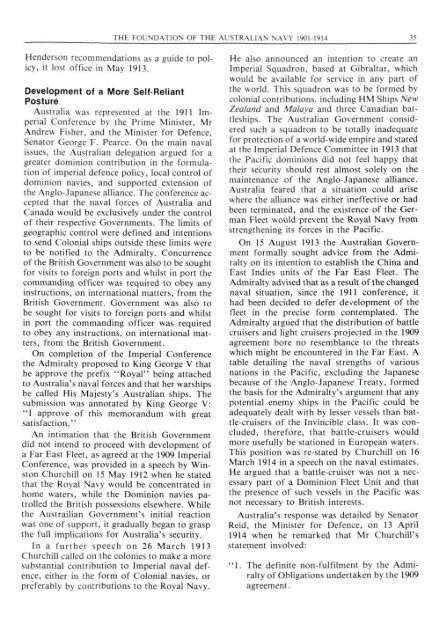ISSUE 61 : Nov/Dec - 1986 - Australian Defence Force Journal
ISSUE 61 : Nov/Dec - 1986 - Australian Defence Force Journal
ISSUE 61 : Nov/Dec - 1986 - Australian Defence Force Journal
Create successful ePaper yourself
Turn your PDF publications into a flip-book with our unique Google optimized e-Paper software.
THE FOUNDATION OF THE AUSTRALIAN NAVY 1901-1914 35<br />
Henderson recommendations as a guide to policy,<br />
it lost office in May 1913.<br />
Development of a More Self-Reliant<br />
Posture<br />
Australia was represented at the 1911 Imperial<br />
Conference by the Prime Minister, Mr<br />
Andrew Fisher, and the Minister for <strong>Defence</strong>,<br />
Senator George F. Pearce. On the main naval<br />
issues, the <strong>Australian</strong> delegation argued for a<br />
greater dominion contribution in the formulation<br />
of imperial defence policy, local control of<br />
dominion navies, and supported extension of<br />
the Anglo-Japanese alliance. The conference accepted<br />
that the naval forces of Australia and<br />
Canada would be exclusively under the control<br />
of their respective Governments. The limits of<br />
geographic control were defined and intentions<br />
to send Colonial ships outside these limits were<br />
to be notified to the Admiralty. Concurrence<br />
of the British Government was also to be sought<br />
for visits to foreign ports and whilst in port the<br />
commanding officer was required to obey any<br />
instructions, on international matters, from the<br />
British Government. Government was also to<br />
be sought for visits to foreign ports and whilst<br />
in port the commanding officer was required<br />
to obey any instructions, on international matters,<br />
from the British Government.<br />
On completion of the Imperial Conference<br />
the Admiralty proposed to King George V that<br />
he approve the prefix "Royal" being attached<br />
to Australia's naval forces and that her warships<br />
be called His Majesty's <strong>Australian</strong> ships. The<br />
submission was annotated by King George V:<br />
"I approve of this memorandum with great<br />
satisfaction."<br />
An intimation that the British Government<br />
did not intend to proceed with development of<br />
a Far East Fleet, as agreed at the 1909 Imperial<br />
Conference, was provided in a speech by Winston<br />
Churchill on 15 May 1912 when he stated<br />
that the Royal Navy would be concentrated in<br />
home waters, while the Dominion navies patrolled<br />
the British possessions elsewhere. While<br />
the Austrailian Government's initial reaction<br />
was one of support, it gradually began to grasp<br />
the full implications for Australia's security.<br />
In a further speech on 26 March 1913<br />
Churchill called on the colonies to make a more<br />
substantial contribution to Imperial naval defence,<br />
either in the form of Colonial navies, or<br />
preferably by contributions to the Royal Navy.<br />
He also announced an intention to create an<br />
Imperial Squadron, based at Gibraltar, which<br />
would be available for service in any part of<br />
the world. This squadron was to be formed by<br />
colonial contributions, including HM Ships New<br />
Zealand and Malaya and three Canadian battleships.<br />
The <strong>Australian</strong> Government considered<br />
such a squadron to be totally inadequate<br />
for protection of a world-wide empire and stated<br />
at the Imperial <strong>Defence</strong> Committee in 1913 that<br />
the Pacific dominions did not feel happy that<br />
their security should rest almost solely on the<br />
maintenance of the Anglo-Japanese alliance.<br />
Australia feared that a situation could arise<br />
where the alliance was either ineffective or had<br />
been terminated, and the existence of the German<br />
Fleet would prevent the Royal Navy from<br />
strengthening its forces in the Pacific.<br />
On 15 August 1913 the <strong>Australian</strong> Government<br />
formally sought advice from the Admiralty<br />
on its intention to establish the China and<br />
East Indies units of the Far East Fleet. The<br />
Admiralty advised that as a result of the changed<br />
naval situation, since the 1911 conference, it<br />
had been decided to defer development of the<br />
fleet in the precise form contemplated. The<br />
Admiralty argued that the distribution of battle<br />
cruisers and light cruisers projected in the 1909<br />
agreement bore no resemblance to the threats<br />
which might be encountered in the Far East. A<br />
table detailing the naval strengths of various<br />
nations in the Pacific, excluding the Japanese<br />
because of the Anglo-Japanese Treaty, formed<br />
the basis for the Admiralty's argument that any<br />
potential enemy ships in the Pacific could be<br />
adequately dealt with by lesser vessels than battle-cruisers<br />
of the Invincible class. It was concluded,<br />
therefore, that battle-cruisers would<br />
more usefully be stationed in European waters.<br />
This position was re-stated by Churchill on 16<br />
March 1914 in a speech on the naval estimates.<br />
He argued that a battle-cruiser was not a necessary<br />
part of a Dominion Fleet Unit and that<br />
the presence of such vessels in the Pacific was<br />
not necessary to British interests.<br />
Australia's response was detailed by Senator<br />
Reid, the Minister for <strong>Defence</strong>, on 13 April<br />
1914 when he remarked that Mr Churchill's<br />
statement involved:<br />
"1. The definite non-fulfilment by the Admiralty<br />
of Obligations undertaken by the 1909<br />
agreement.

















